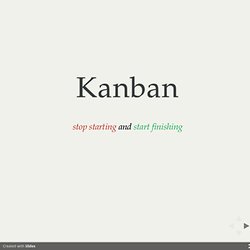

Kanban: Slides. On ne déploie que ce que l'utilisateur est capable d'utiliser on ne teste que ce que l'on est capable de déployer.

What is Kanban? Kanban is a new technique for managing a software development process in a highly efficient way.

Kanban underpins Toyota's "just-in-time" (JIT) production system. Although producing software is a creative activity and therefore different to mass-producing cars, the underlying mechanism for managing the production line can still be applied. A software development process can be thought of as a pipeline with feature requests entering one end and improved software emerging from the other end. Inside the pipeline, there will be some kind of process which could range from an informal ad hoc process to a highly formal phased process.
In this article, we'll assume a simple phased process of: (1) analyse the requirements, (2) develop the code, and (3) test it works. The Effect of Bottlenecks A bottleneck in a pipeline restricts flow. If the analysts and developers aren't aware that the testers are the bottleneck, then a backlog of work will begin to pile up in front of the testers. Worked Example. Crisp - Get agile with Crisp. Kanban is a lean approach to agile software development.

Actually, Kanban means many things. Literally, Kanban is a Japanese word that means “visual card”. At Toyota, Kanban is the term used for the visual & physical signaling system that ties together the whole Lean Production system. Most agile methods such as Scrum and XP are already well aligned with lean principles. In 2004, however, David Anderson pioneered a more direct implementation of Lean Thinking and Theory of Constraints to software development. Does Kanban matter to me? Do any of these sound familiar? “We’ve done Scrum for a long time now and our process improvement has levelled off. If so, read on. How does Kanban work? There are many flavors, but the core of Kanban means: This is a direct implementation of a lean pull scheduling system. Here’s a more complex one (see Kanban kick-start example for a closer look & description) What are the benefits of Kanban?
Some commonly observed benefits are: Yes. Visualizing Agile Projects using Kanban Boards. In Agile projects, it's a common practice to visualize and share project status in “big visible charts” on a wall of the project room.

Lean systems also use such devices. "Kanban," in Japanese means, loosely translated, 'card or sign'. In a Lean production system, Kanban is a method which uses standard units or lot sizes with a single card attached to each. A new card is "pulled" into the system only when the work represented by an "in progress" card is completed.. In this paper, I explore visualization methods found widely in agile projects these days, and then propose using Kanban Boards to organize three viewpoints (Time, Task, and Team) so that the whole team understands the current status of the project and can work in an autonomous, motivated and collaborative manner.
Kanban un tour d'horizon de la démarche. Kanban in 4 easy steps. Easy Drag & Drop Project Tracking. Top Agile Tools - Best Kanban Tools. Kanban is growing like wildfire.

Many organizations are finding value in this simple process via a “pull” system: The production of work is determined by the demand from the customer. You have a choice: 1. You can build a Kanban board. 2. Axosoft: Targetprocess: AgileZen: Blossom.io: Kanbanchi: Plan and Organise your Work using a Simple Dashboard built for Google Apps. Kaizen amélioration continue. Le mot japonais "KAIZEN" est formé de deux idéogrammes chinois, kai et zen qui signifient respectivement "changement" et "meilleur".

Kaizen se traduit communément par "amélioration continue". Kaizen, c'est l'amélioration sans investissements ni gros moyens, en impliquant tous les acteurs des directeurs aux ouvriers et en utilisant essentiellement des astuces et le bon sens commun. Cette démarche d'origine japonaise repose sur des petites améliorations faites jour après jour, avec constance. C'est une démarche graduelle et douce, à petits pas, qui s'oppose au concept plus occidental de réforme brutale ou de rupture, par laquelle "on jette tout et on recommence avec du neuf".
Le Kaizen n'est pas une méthode ni un outil, c'est un mode de pensée qui ne se satisfait pas d'une situation donnée mais cherche constamment à l'améliorer ou la remettre en cause pour un résultat meilleur. Il n'existe donc pas de "recette" ou de "mode opératoire" du Kaizen. >Retour au sommaire< >Retour au sommaire<